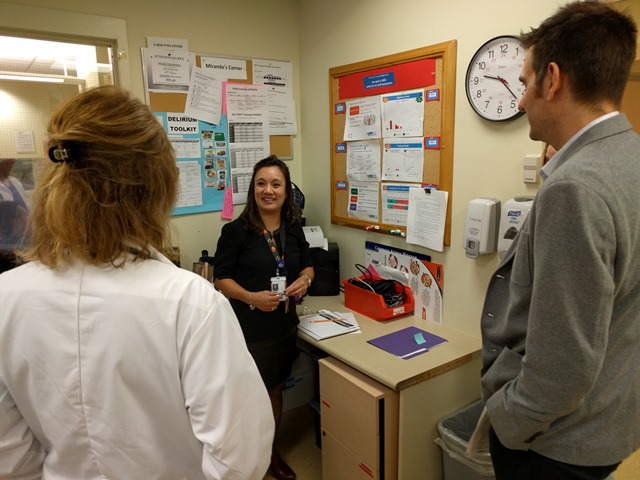
By Brenda Kenefick
When the University Health Network (UHN) made improving safety for patients and staff a top priority, the question became how to develop a more robust safety culture.
Since a strong safety culture requires strong team engagement, one of the first steps was introducing daily huddles for front line staff. The area manager meets with the interprofessional team for 10 minutes to talk about safety, demonstrating that it is a priority.
The safety huddles follow the same format used by senior leaders at each UHN hospital: Look ahead to identify any safety concerns for the next 24 hours, look back and review any incidents from the previous 24 hours, and report back on any action taken to address safety concerns or incidents from the previous day.
In the past managers have had an open door policy and staff could report problems whenever they wanted. The move to safety huddles introduces a structured and standardized approach for reporting safety issues. It also reinforces the expectation that staff will report any concerns they have.
Front line huddles
The success of the strategy requires staff to speak up when they identify a safety concern, and it also requires managers to take action when a concern is brought to their attention. Staff are encouraged to adopt a team perspective, to look beyond the scope of their role and to take responsibility for the entire area.
“I start every huddle by stating our goal of 100 per cent safety for our team, our patients and their families,” says Norma Ferrer-Pilarta, Nurse Manager, Toronto General Hospital. “Since we started huddling my team is more engaged, and more willing to support each other with shared responsibilities.”
Managers and unit leadership receive a two-hour training session on how to run the safety huddles, and in particular are taught to do three things. First they make sure to ask every team member, by name, if they have any concerns to report. This ensures team members are not subtlety discouraged from speaking up. Second, managers are trained to respond to every concern reported by saying “thank you.” Third, they report back to the team on the status of every open issue until it is resolved.
“We’ve identified everything from a phone jack that fell off a wall to a serious issue with equipment design,” says Norma. “Sometimes we have a discussion to clarify which team members are responsible for certain tasks, and sometimes I need to work with managers from other departments to address the root cause of an issue.”
Of course, some problems require organizational changes or investment. These problems must be escalated to a higher level for resolution.
Leadership huddles
Every manager at UHN can escalate an issue to the site level safety huddle by passing it along to their director. Toronto Rehab is piloting a standardized huddle for managers and directors to complete the cascading communication chain between the front lines and the senior leadership.
Every day, after the unit level huddle, directors and their managers develop situational awareness with respect to concerns and incidents. It’s a structured approach to sharing learnings, to identifying trends and problems that are occurring in multiple areas, and to discussing solutions.
“We keep the huddles very tight and focus in on the issues that might need immediate attention or escalation,” says Jatinder Bains, Program Manager, Toronto Rehab. “Having the structured time in our day keeps our leadership team aligned and working together towards safer patient care.”
The directors then take a summary of the incidents and concerns to the hospital safety huddle. The senior leadership team tracks the number of incidents and concerns every day. Systematic safety concerns can be raised at this level, and the group also reviews any major safety incidents that occurred in the previous 24 hours.
This structure creates a direct chain of communication which allows concerns from front line clinicians, support staff and managers to be escalated to senior leaders in a matter of hours and for immediate action to be taken at the appropriate level. Decisions can also be quickly communicated back down the chain to inform the team responsible for raising the concern about the outcome.
Front line nurses are saying that the huddles are the best thing to happen in 15 years. From an organizational perspective, when safety issues are transparent swift action can be taken to prevent harm to staff, patients today and patients tomorrow.
Brenda Kenefick is Director, Lean Process Improvement at University Health Network.

